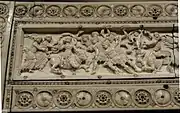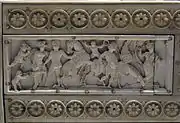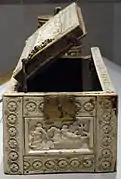Veroli Casket
The Veroli Casket is a casket, made in Constantinople (now Istanbul) in the late tenth or early eleventh century, and now in the Victoria and Albert Museum, London. It is thought to have been made for a person close to the Imperial Court of Constantinople, the capital of the Byzantine Empire, and may have been used to hold scent bottles or jewellery. It was later kept in the Cathedral Treasury at Veroli, south east of Rome, until 1861.
| Veroli Casket | |
|---|---|
 Front side | |
| Material | Wood overlaid with carved ivory and bone plaques with traces of polychrome and gilding |
| Size | Height: 11.5 cm Length: 40.3 cm Width: 15.5-16 cm Weight: 1.72 kg |
| Created | Constantinople, 900–1000 AD |
| Present location | Victoria and Albert Museum Room 8 |
| Identification | 216-1865 |
The casket is made of carved ivory and bone panels showing scenes from classical mythology. On the lid is a depiction of the Rape of Europa. On the front are scenes from the stories of Bellerophon and Iphigenia. On the back is part of a dionysiac procession, with two figures identified as Mars, god of war (the Greek Ares), and Venus, goddess of love (the Greek Aphrodite). The ends bear scenes of Bacchus, god of wine (the Greek Dionysius), in a chariot drawn by panthers, and a nymph riding a seahorse. There is a carcass of wood, and metal fittings.
As the Empire had been Christianised for centuries, these pagan motifs presumably represent a revived taste for classical style and imagery.
The casket from Veroli is one of some 43 caskets, in addition to dozens more separated panels, that show a fashion for "pseudo-antique motives derived from silver plate or manuscripts, put together with little understanding of the original significance," as Sir Kenneth Clark observed of the group as a whole,[1] during the medieval eclipse of the nude.
 Alternative front view showing lid carving.
Alternative front view showing lid carving. Lid detail showing the Rape of Europa with Jupiter as the bull (on the left) and Hercules playing the lyre (on the right).
Lid detail showing the Rape of Europa with Jupiter as the bull (on the left) and Hercules playing the lyre (on the right). Panel detail with Bellerophon and Pegasus.
Panel detail with Bellerophon and Pegasus. End view showing nymphs with seahorse.
End view showing nymphs with seahorse.
References
- Clark, The Nude: A Study in ideal form, 1956, Notes, p. 477.
- Jackson, Anna, ed. (2001). V&A: A Hundred Highlights. Victoria and Albert Museum. ISBN 978-1-85177-365-7.
Further reading
- Evans, Helen C. & Wixom, William D., The glory of Byzantium: art and culture of the Middle Byzantine era, A.D. 843-1261, no. 153, 1997, The Metropolitan Museum of Art, New York, ISBN 9780810965072; full text available online from The Metropolitan Museum of Art Libraries
External links
- http://collections.vam.ac.uk/item/O70463/casket-veroli-casket catalogue entry
